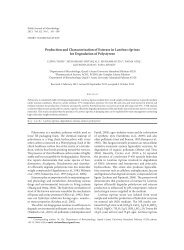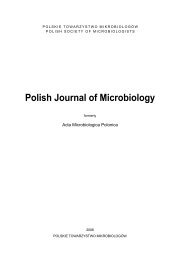No 3 - Polish Journal of Microbiology
No 3 - Polish Journal of Microbiology
No 3 - Polish Journal of Microbiology
You also want an ePaper? Increase the reach of your titles
YUMPU automatically turns print PDFs into web optimized ePapers that Google loves.
194<br />
presented in Figure 1. To test primer specificity, we preformed<br />
PP typing using two reference strains <strong>of</strong> known<br />
genomic sequence: MGAS6180 (NC_007296.1 (Green<br />
et al., 2005)) and MGAS10270 (NC_008022 (Beres and<br />
Musser, 2007)). Based on the genomic sequence , strain<br />
MGAS6180 carries 7 elements integrated into sites G,<br />
H, I, L, M, T, U and MGAS10270 carries 7 elements<br />
integrated into sites C, E, G, L, M, T, U (Table I) ( Beres<br />
and Musser, 2007). In concordance with the predicted<br />
product presence and size, we were able to detect fragments<br />
that denote putative integration sites without<br />
inserted element, and we were not able to detect products<br />
that amplified large integrated element (Fig. 2). In<br />
some cases, such as for site G in strain MGAS10270<br />
and site L in strain MGAS6180, very weak bands are<br />
observed and are probably a signal derived from a dNA<br />
isolated from fraction <strong>of</strong> GAS cells where the element<br />
was excised from the chromosome.<br />
Two mobile elements 315.1 and SPsP5 are integrated<br />
into integration site “F” in M3 strain MGAS315<br />
(between ORFs SpyM3_0680 and SpyM3_0737) and<br />
SSI-1 (between ORFs SPs0876 and SPs0938), respectively<br />
(Beres and Musser, 2007). However, based on<br />
the BLAST searches in all sequenced GAS genomes,<br />
the region encompassed by ORFs flanking prophage<br />
integration site varies in length and gene content in different<br />
strains. Therefore, primers detecting integrated<br />
Borek A.L. et al. 3<br />
Table V<br />
Simpson’s Index <strong>of</strong> diversity (SdI) and Wallace’s coefficient (WC), calculated for strains analyzed by phage<br />
pr<strong>of</strong>iling (PP) and virulence factor pr<strong>of</strong>iling (VF)<br />
A.<br />
Typing Method # partitions Simpson’s Id C.I. (95%)<br />
Phage pr<strong>of</strong>ile (PP) 185 0.965 (0.960–0.971)<br />
Virulence factor pr<strong>of</strong>ile (VF) 95 0.943 (0.936–0.951)<br />
Virulence factor pr<strong>of</strong>ile (VF) without “proteases mix” 94 0.944 (0.936–0.952)<br />
emm type 40 0.908 (0.899–0.917)<br />
B.<br />
PFGE ST emm VF PP<br />
PFGE 1.000 1.000 0.990 0.986<br />
(1.000–1.000) (1.000–1.000) (0.979–1.000) (0.974–0.997)<br />
ST 0.564 1.000 0.899 0.648<br />
(0.379–0.749) (1.000–1.000) (0.768–1.000) (0.472–0.824)<br />
emm 0.564 1.000 0.899 0.648<br />
(0.379–0.749) (1.000–1.000) (0.768–1.000) (0.472–0.824)<br />
VF 0.622 1.000 1.000 0.721<br />
(0.430–0.813) (1.000–1.000) (1.000–1.000) (0.556–0.886)<br />
PP 0.858 1.000 1.000 1.000<br />
(0.703–1.000) (1.000–1.000) (1.000–1.000) (1.000–1.000)<br />
Information about absence (0)/presence (1) <strong>of</strong> particular virulence factor or integrated element was concatenated into<br />
binary sequence <strong>of</strong> 20 or 21 digits and used for calculations with http://darwin.phyloviz.net/ComparingPartitions/.<br />
A SdI calculated for group <strong>of</strong> 656 divergent strains; B. WC calculated for group <strong>of</strong> highly clonal strains (PFGE pattern A<br />
from Szczypa, et al., 2004)<br />
element F amplify fragment <strong>of</strong> varying size, from about<br />
1 kb to over 3 kb in the absence <strong>of</strong> integrated prophage.<br />
We decided to exclude primers detecting integration in<br />
the F site from multiplex reaction to increase PCR specificity<br />
and efficiency and run the reaction separately<br />
(Fig. 1E). With additional optimization <strong>of</strong> the reaction,<br />
primers detecting F integration site can be included in<br />
“phage mix 3”, however detected bands are <strong>of</strong>ten weaker<br />
and gels more difficult for interpretation (Fig. 2).<br />
To determine resolution <strong>of</strong> the phage pr<strong>of</strong>ile detection<br />
as a typing method, we calculated Simpson’s Index<br />
<strong>of</strong> diversity (SId) based on analysis <strong>of</strong> highly diverse<br />
656 GAS strains (Table VA). Among 40 emm types, we<br />
detected 185 distinct phage pr<strong>of</strong>iles with Simpson’s<br />
Index <strong>of</strong> diversity <strong>of</strong> 0.965 (CI 95% 0.960–0.971).<br />
Phage pr<strong>of</strong>ile is also good predictor <strong>of</strong> emm type,<br />
with PP→emm Wallace’s coefficient (WC) equal 0.953<br />
(CI 95% 0.926–0.980).<br />
Insertion or excision <strong>of</strong> large dNA fragments such<br />
as phages/ICEs from the chromosome usually is reflected<br />
in PFGE analysis. To test if the presence <strong>of</strong> integrated<br />
elements correlates with PFGE pattern, we analyzed<br />
homogenous population <strong>of</strong> strains previously<br />
described by Szczypa and co-workers (Szczypa et al.,<br />
2004). Performed PP analysis showed that detection <strong>of</strong><br />
elements inserted into putative integration sites correlates<br />
with PFGE patterns, emm type and ST (Fig. 3AB).






